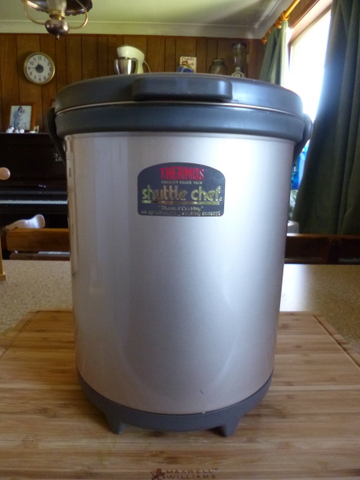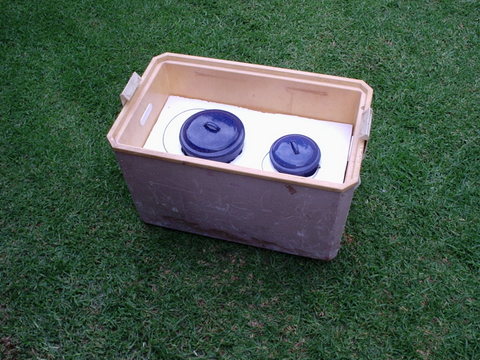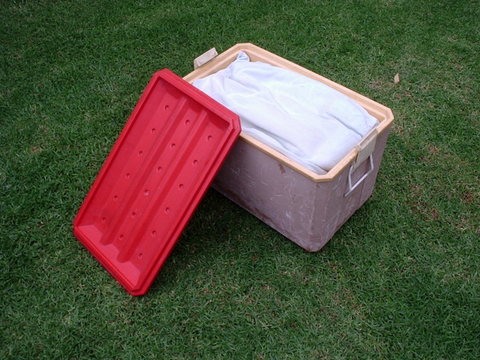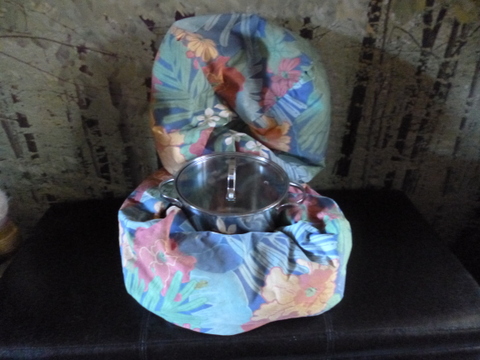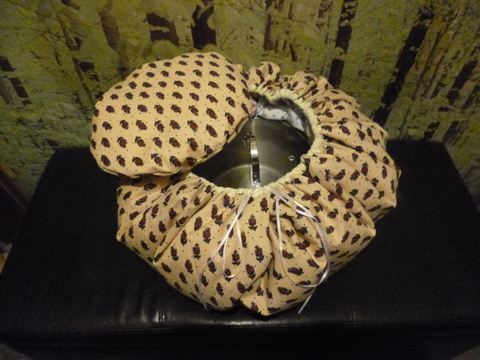For years we have used (and I have been fascinated by) fireless cookers which are called haybox cookers or stored heat cookers. They are used by heating up the food (usually soups, stews & casseroles etc.) using a conventional stove, wood heater, solar cooker or whatever. Then you place the preheated food into an insulated container of some description (the fireless cooker) and leave things alone for a few hours so the food cooks using the heat you originally pumped in. The insulation prevents the heat being lost to atmosphere or at least reducing the loss to a much slower rate, meaning you don’t need to keep the pot heating on the stove. The technique saves energy and nutrients. A more in depth discussion of cooking with a stored heat cooker may be found here.
We have a number of fireless cookers (there are several different construction tecniques) and something I have always wondered is which is the most efficient, ie retains its heat the longest? So I did some research to find out.
Method
A number of our cookers would accept the same size pot so the test would be somewhat standardised but a couple would only take the pot designed to fit the cooker. With that in mind I filled the pots to be used up to the level which would be usual if they were to be used for cooking with tap water. I then brought the pot in use to a rolling boil. The pot full of boiling water was then transferred to the cooker being tested as fast as I could manage.
I would then take the temperature of the pot once an hour for the next five hours using a glass laboratory thermometer, removing the lid and cover (but not the pot from the cooker), and swirling the thermometer around until I got a steady reading.
Once I recorded the reading for each hour that was pretty much it.
The control consisted of taking the most used pot up to boiling, then leaving it to cool sitting in the open on the (unused) stove. All the tests were carried out at roughly the same time during the day in the middle of an Aussie winter. I figured winter would be a worst case scenario and the most likely time when the soups and casseroles usually cooked in the fireless cooker would be in demand.
The temperatures quoted are relatively accurate, but not necessarily correct in an absolute sense. If you wish to use the numbers to work out which of the cookers are most efficient, ie retain their heat the best, then it works. Due to the need to remove the lid to get the reading (a no-no in stored heat cooking!) the results probably understate the real numbers if the pots were left undisturbed until the end of the cooking time.
Results
|
Item |
0 hr |
1 hr |
2 hrs |
3 hrs |
4 hrs |
5 hrs |
|
Shuttle Chef |
100 |
95 |
91 |
87 |
84 |
80 |
|
Eski Fireless cooker |
100 |
93 |
89 |
83 |
78 |
75 |
|
Haybox cooker in chest |
100 |
92 |
88 |
82 |
77 |
74 |
|
Wonderbox |
100 |
91 |
84 |
78 |
73 |
69 |
|
Wonderbag |
100 |
88 |
79 |
71 |
66 |
60 |
|
Control |
100 |
75 |
59 |
49 |
42 |
37 |
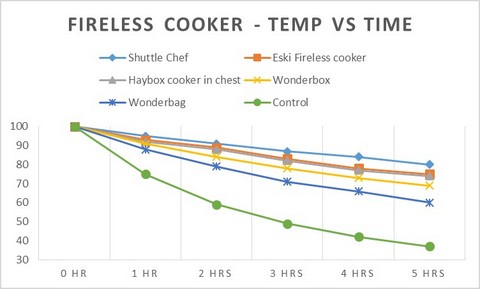
Comments
Shuttle chef – This is a commercially produced cooker made by Thermos which uses a vacuum as its insulating medium. As you can see it works pretty damn well but is also very costly to buy. Current price (July 2014 - the 6 litre version with 1 full size and two half size pots) is around $500.
Eski Fireless cooker – By contrast this one cost me almost nothing to make, based on a second hand plastic eski cooler box bought at a garage sale for $5, salvaged polystyrene sheet, a couple of billy cans I had floating around etc. The full construction details are available here.
Cooker in wooden chest – The biggest cost of this one was the piece of furniture which I bought to construct the cooker in, the main insulating medium is salvaged polystyrene sheet. Add in a couple of pots from the kitchen and a couple of pillowcases full of polystyrene bean bag beans and there you have it. It sits inside and is ready to use whenever we need it. Construction details are available here.
Wonderbox – is not a box at all! It consists of two fabric bags filled with polystyrene bean bag beans. A pot sits inside a bottom “cushion” and the top cushion goes over the pot so that the pot has insulation all around it. While not being as effective as the others listed above, it is very light and portable as well as being easy and cheap to make. Construction details are available here.
Wonderbag – This one is two large disks of cloth with polystyrene balls sewn in and the whole contraption drawn up around a pot with a drawstring. There is a small insulated cushion which fits over the top of the pot to complete the insulation surrounding the pot. In a similar way to the wonderbox it is very light and easily portable, but takes a bit more skill to make. Construction details are available here.
Conclusion
All of the stored heat cookers work pretty well. The Shuttle Chef is the most efficient but also the most expensive. If you want an efficient cooker to use at home either of the box style cookers will work. If you need your cooker to be more portable the a wonderbox or wonderbag is your thing.



